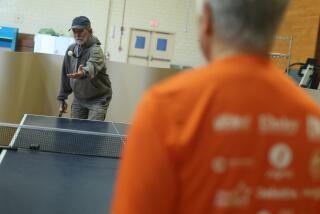The Murky Statistics on Senior Suicides
- Share via
The old are deadly serious about committing suicide.
Those over 60 represent 12% of the U.S. population and commit about 25% of suicides--and one expert thinks the true figure is 30% to 40%.
Furthermore, said Nancy J. Osgood, Ph.D., although statistics show a decrease since 1960 in suicides among those over 60, she thinks the figures are misleading.
Rates ‘Skyrocketing’
“Those 85 and over and those 75 and over have a skyrocketing suicide rate,” Osgood told a group of health-care professionals at the 24th annual meeting of the American Assn. of Homes for the Aging in Los Angeles last week. “Women (who have a lower suicide rate than men at all ages) in the 85 and over range are committing suicide at a fairly high rate.
“The suicide rate is going down between 60 and 74, but those statistics are lumped together with the 75 and over,” giving a false impression, she said.
Osgood, assistant professor of gerontology and sociology at Virginia Commonwealth University in Richmond, also said that statistics on suicide can be especially murky when dealing with an elderly population.
“Many suicides among the aging go unreported and undetected,” she said. “The elderly are least likely to be investigated when they die.
“They also have a lot of ways to commit suicide that do not show up on coroners’ reports--not taking life-saving medicine, just not eating or drinking for weeks, having fatal accidents that are sometimes not accidents. The problem is much larger than reported statistics would indicate to you.
“Another major difference is that the young more often attempt suicide and fail; they are seeking attention. The old more often complete suicide. And when the old fail to complete suicide, it is usually because they are not physically or cognitively able to do so.”
Osgood cited studies indicating that males commit suicide three times as often as women at all stages of the life cycle--rising to 10 to 1 at 75-plus and 12 to 1 at 85-plus. Female suicides rise slowly to middle age, then decline. Whites commit suicide three times as often as blacks.
Marital Status
One of the most crucial factors for men is marital status.
“The rate for the unmarried male is much higher,” Osgood said. “It is most dangerous in the first two years after being widowed or divorced--but widowhood is the worst state of affairs, especially for males. . . .
“Men who are not married are the most isolated. They are not the ones who have sent out the birthday cards, gone to community organizations, groups, kept up with the family. When a man is left without a woman, he is left very isolated socially.
“Men are less likely to carry on on a day-to-day basis. Women are the most likely to have done the laundry, the cooking, managing the house. And a man faces the loss of two major roles if he is widowed. The woman most often has played the spouse role, but the man is likely also to be retired and he has the loss of a work role as well as a family one.”
Men also are more likely to experience a drop in job involvement, what Osgood calls “occupational skidding,” which influences the suicide rate.
“Any kind of occupational skidding is very negative, especially for males,” she said. “I argue that retirement represents a source of forced occupational skidding, with income dropping a third or a half.”
Living Environment
Another factor in the elderly suicide rate is living environment, which can involve divorce, crime and juvenile delinquency, all of which are higher in an urban area. Living alone increases the likelihood of suicide, Osgood said, and “Any change in the living environment can be a negative, dangerous.”
Illness, especially a painful one, also influences the elderly suicide rate. Osgood offered some case histories:
“Mr. B and his wife had retired to a mobile home on Florida’s Gold Coast. According to his widow, Mr. B had always been a jovial, happy-go-lucky man . . . who loved working in the yard, making home repairs and fishing. About six months before his suicide he had undergone coronary bypass surgery during which he stopped breathing, his heart stopped beating and he was pulseless . . .
“(Although he was revived) he was a changed man . . . sullen and bitter. He refused to go out or do anything, got angry at the smallest incidents and flew into rages . . . Mrs. B was frightened of him . . .
“One evening six months after the operation Mr. B disappeared. The next morning his body was found several miles from home. He had shot himself in the head.
“A gun is the most lethal method,” Osgood continued. “Men use guns; women use drugs.” But not always:
‘Medicine Is My Life’
“There was the case of Mr. D, 72, a physician who was almost blind from diabetes. He took an overdose of sleeping pills, leaving a note that said, ‘If I cannot see, I cannot practice medicine. Medicine is my life. If I cannot practice medicine I have no life.”’
Psychological contributors to suicide among the old are depression and despair and what Osgood, quoting from Janet Pavkov, RN, MA, calls “the three H’s: haplessness, helplessness and hopelessness.”
Haplessness, Osgood said, involves being unhappy--the loss of home, family, friends, even pets. Helplessness can be learned, especially by those who need aid in caring for themselves, and may lead to lethargy and apathy--”They just let things be done to them.”
Hopelessness is the worst.
“There is no suicide unless the person is hopeless at any age,” Osgood said. “The person feels the past is very bad, the present is terrible and there is no hope the future is ever going to be any better.
“There is a line of unbearability, a point at which we’d rather go over the edge than continue on. It is different for different people. Some can tolerate a whole lot more than others.”
Having outlined the general circumstances that care givers should look for, Osgood turned to the concrete clues that both old and young give to impending suicide.
‘A Gate-Keeping Position’
“In the case of the elderly, 76% have seen a doctor within the month before--and many in the week that they killed themselves,” she said. “Doctors are in a very important gate-keeping position--and many (of the potential suicides) also might be seeing you (their care givers).”
Clues to suicide can be as blatant as a verbal statement--”I’m going to kill myself”--or, “I might not be here when you come back,” Osgood said. Other clues are behavioral, situational and syndromic.
“The most forceful behavioral clue is a suicide attempt, and 70% of older people who attempt suicide eventually complete it,” Osgood said. “Other clues are suicide attempts farther back . . . and geriatric delinquency--rages, obnoxious, nasty behavior. Some behaviors might be related to changes such as Alzheimer’s disease, drug reactions and interactions, signs of depression.
“Others are buying a gun or stockpiling pills, going to a doctor for no reason, going to church if they never have before or not going if they always have, making or changing a will, giving away possessions.
“The situation itself may be a clue: a diagnosis of a terminal illness, a change in living environment, a flare-up with a child or best friend or neighbor. An older person’s world revolves around a so much smaller area.
“Syndromic clues are depression and frustrated dependency, of which depression is the most dangerous. Depression is difficult to figure out and different in older people than in younger. It is more likely to manifest itself in somatic ailments--headaches, stomach aches, concern with bodily functions.
Need for Lab Tests
“Depression may include lethargy, apathy and retardation in terms of speech and movement, which become slower. There are confusion and memory loss, which are easily confused with Alzheimer’s disease. In these cases lab tests--blood, glucose--need to be taken.”
Other warning signs, Osgood said, include changes in sleep patterns, especially insomnia; change in eating habits, especially weight loss; fatigue, an increase in amount of alcohol taken, change in mood--the blues and the blahs, expression of fears or anxieties without reason.
Osgood advised the care givers that the way to determine the lethality potential of a person’s suicide plan is “to ask questions, straight and direct” questions.
“Ask them, ‘Have you thought of killing yourself?’ ” she said. “They want to be asked. You will not be planting the idea or encouraging them. That’s why they go to doctors; they want the doctor to ask them. Then when the doctor turns them away they are even more convinced that nobody cares.
“If you get a straight ‘No’ to that question, it is probably true they are not considering suicide. But anything short of that, any hedging, is dangerous.
“If there is any suspicion on your part that they may be considering suicide, ask about their plan: ‘Do you have a gun?’ ‘Do you have a lot of pills?’ If they say they have a gun and go on to tell you how they intend to use it, when and where, that is the highest lethality potential. It is very important at that point for you to do something.
“What you do depends on your situation: the state you live in, your position as a care giver, what resources they might have. If they have a family, have a family member stay with them a few days. Get them hospitalized and started on an anti-depressant drug.”
Coping Strategies
Counseling also is important, Osgood said, beginning with a simple “tell them not to do it. That does not work with teen-agers, but with an older person, if someone in authority tells them to flush the pills down the toilet, they’ll do it.”
Osgood also encouraged her audience to be supportive and empathetic, to focus on specific problems and their solutions, to listen (“particularly important for older people because they don’t have a lot of people to talk to”), to find out the older person’s coping strategies and keep them intact and to incorporate special therapies--recipes, photos, jokes, cartoons, pets, plants, painting, a support group--in their care.
More to Read
Sign up for Essential California
The most important California stories and recommendations in your inbox every morning.
You may occasionally receive promotional content from the Los Angeles Times.













